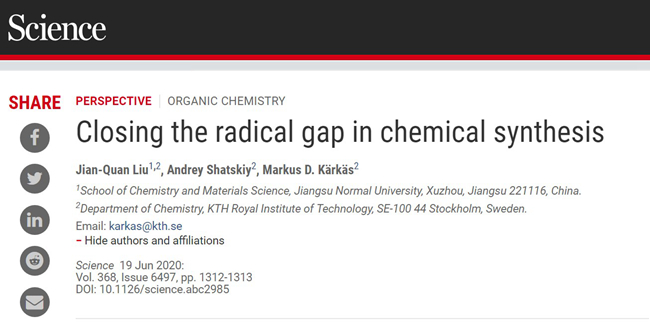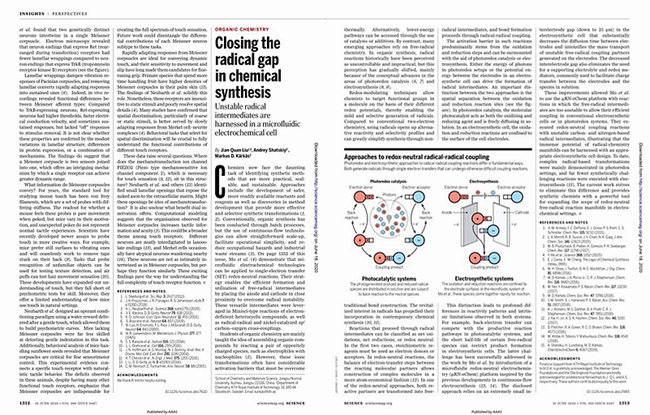“Closing the Radical Gap in ChemicalSynthesis”, co-written by Dr. Liu Jianquan of School of Chemistry & Materials Science, Jiangsu Normal University (first author) and Dr. Markus D.Kärkäs of Department of Chemistry, KTH Royal Institute of Technology (Corresponding author), was published in Science on June 19.

With the high-speed development of modern economy, more and more energy has been consumed. The problems like nearly exhausted traditional fossil, environmental pollution and worsen ecology have become severe. Chemists now face the daunting task of identifying synthetic methods that are more practical, scalable, and sustainable.

In organic synthesis, radical reactions historically have been perceived as uncontrollable and impractical, but this perception has gradually shifted, mainly because of the conceptual advances in the areas of photoredox catalysis and electrosynthesis.

The activation barrier in reaction predominantly stems from the oxidation and reduction steps and can be surmounted with the aid of photoredox catalysis or electrosynthesis. Their strategy enables the efficient formation and utilization of free-radical intermediates by placing the anode and cathode in close proximity to overcome radical instability. These versatile intermediates were leveraged in Minisci-type reactions of electron-deficlent heterocyclic compounds, as well as radical-radical and nickel-catalyzed sp2 carbon-oxygen cross-couplings.
An important distinction between the two approaches is spatial separation between the oxidation and reduction reactionsites.
This distinction leads to profound differences in reactivity patterns and intrinsic limitations observed in both systems, and the short half-life of certain free-radical species can restrict product formation in electrosynthetic cells.
These improvements allowed Mo et al. to use the μRN-eChem platform with reactions in which the free-radical intermediates are too unstable to allow their efficient coupling inconventional electrosynthetic cells or in photoredox systems.
They executed redox-neutral coupling reactions with unstable carbon- and nitrogen-based radical intermediates, illustrating that the immense potential of radical-chemistry manifolds can be harnessed with an appropriate eletrosynthetic cell design.
The current work strives to eliminate this difference and provides synthetic chemists with a powerful tool for expandingthe scope of redox-neutral free-radical reaction manifolds in electrochemical settings.
Associate Professor Liu Jianquan was born in January 1990. He achieved his PhD at Northeast Normal University in 2016 and entered School of Chemistry & Materials Science in the following year. In2019, he went to KTH Royal Institute of Technology for his post-doctoral fellow research. In recent years, he has published over 30 academic papers in journals collected by SCI.
Link: https://science.sciencemag.org/content/368/6497/1312
